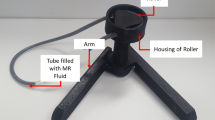Abstract
Magnetorheological (MR) brakes offer time invariant performance and online friction force control which make them an appealing alternative to traditional disc brakes. However, leakage of MR fluid through wear of seal and friction losses degrades its performance. Nitrile, Silicon, and Viton are the three types of seal materials employed in this investigation. To evaluate the wear and friction response of three seals, tests were conducted on a block on disc lubricity tester using synthesized MR fluid. Scanning electron microscope (SEM) and Energy-dispersive spectroscopy (EDS) was used to investigate the surface morphology and the chemical composition of seal material after experiments. To validate the results of block on disc lubricity tester and investigate the time of failure of each material seal, experiments were carried out using a developed MR brake test setup. Based on the findings, polymeric materials are not appropriate for preventing MR fluid leakage. Hence, a novel seal design with permanent magnets has been proposed to prevent MR fluid leaking from the MR brake casing. The work can be regarded as the first experimental investigation to effectively replace polymeric seal with magnetic seal and has proven to be very effective for long-term use of MR brakes.








Similar content being viewed by others

References
Sarkar C, and Hirani H, J Phys Conf Ser 412 (2013) 012045. https://doi.org/10.1088/1742-6596/412/1/012045
Patil S R, and Sawant S M, in Engineering Systems Design and Analysis (2014). https://doi.org/10.1115/ESDA2014-20135.
Kumbhar B K, Patil S R, and Sawant S M, Eng Sci Technol an Int J 18 (2015) 432. https://doi.org/10.1016/j.jestch.2015.03.002
Jun J-B, Uhm S-Y, Ryu J-H, and Suh K-D, Coll Surf A Physicochem Eng Asp 260 (2005) 157. https://doi.org/10.1016/j.colsurfa.2005.03.020
Lijesh K P, Kumar D, and Hirani H, Ind Lubr Tribol 69 (2017) 655. https://doi.org/10.1108/ILT-03-2016-0061
Sarkar C, and Hirani H, Def Sci J 63 (2013) 408. https://doi.org/10.14429/dsj.63.2633
Phulé P P, and Ginder J M, Int J Mod Phys B 13 (1999) 2019. https://doi.org/10.1142/S0217979299002095
Lijesh K P, Kumar D, and Hirani H, Eng Fail Anal 74 (2017) 228. https://doi.org/10.1016/j.engfailanal.2017.01.009
Walowit J A, and Pinkus O, A S L E Trans 24 (1981) 533. https://doi.org/10.1080/05698198108983053
Pinkus O, A S L E Trans 25 (1982) 79. https://doi.org/10.1080/05698198208983068
Zhang Y, Li D, Chen Y, and Li Z, IEEE Trans Magn 54 (2018) 1. https://doi.org/10.1109/TMAG.2018.2868298
Do X P, Quoc L M B, Kang B H, Choi S B, in: Sensors and Smart Structures Technologies for Civil, Mechanical, and Aerospace Systems 10970 (2019) 777. https://doi.org/10.1117/12.2512180
Iyengar V R, Alexandridis A A, Tung S C, and Rule D S, Tribol Trans 47 (2004) 23. https://doi.org/10.1080/05698190490279083
Radionov A, Podoltsev A, and Zahorulko A, Procedia Eng 39 (2012) 327. https://doi.org/10.1016/j.proeng.2012.07.038
Ravaud R, Lemarquand G, and Lemarquand V, Tribol Int 43 (2010) 76. https://doi.org/10.1016/j.triboint.2009.04.050
Polevikov V, and Tobiska L, Commun Nonlinear Sci Numer Simul 16 (2011) 4021. https://doi.org/10.1016/j.cnsns.2011.02.025
Li Z, J Magn Magn Mater 252 (2002) 327. https://doi.org/10.1016/S0304-8853(02)00681-9
Liu J, Tribol Trans 59 (2016) 309. https://doi.org/10.1080/10402004.2015.1077408
Acknowledgements
The authors are very thankful to the Department of Mechanical Engineering and Central Research Facility (CRF) of IIT Delhi for providing characterization facilities. The authors also acknowledge Mr. Pawan Kumar for helping in conducting the experiments.
Author information
Authors and Affiliations
Corresponding author
Additional information
Publisher's Note
Springer Nature remains neutral with regard to jurisdictional claims in published maps and institutional affiliations.
Rights and permissions
Springer Nature or its licensor (e.g. a society or other partner) holds exclusive rights to this article under a publishing agreement with the author(s) or other rightsholder(s); author self-archiving of the accepted manuscript version of this article is solely governed by the terms of such publishing agreement and applicable law.
About this article
Cite this article
Kumar, D., Harmain, G.A., Gaurav, G. et al. A Novel Seal Design to Enhance MR Brake Performance. Trans Indian Inst Met 76, 2335–2342 (2023). https://doi.org/10.1007/s12666-022-02848-3
Received:
Accepted:
Published:
Issue Date:
DOI: https://doi.org/10.1007/s12666-022-02848-3



